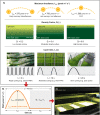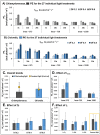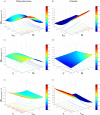High-throughput optimisation of light-driven microalgae biotechnologies
- PMID: 30076312
- PMCID: PMC6076246
- DOI: 10.1038/s41598-018-29954-x
High-throughput optimisation of light-driven microalgae biotechnologies
Abstract
Microalgae biotechnologies are rapidly developing into new commercial settings. Several high value products already exist on the market, and systems development is focused on cost reduction to open up future economic opportunities for food, fuel and freshwater production. Light is a key environmental driver for photosynthesis and optimising light capture is therefore critical for low cost, high efficiency systems. Here a novel high-throughput screen that simulates fluctuating light regimes in mass cultures is presented. The data was used to model photosynthetic efficiency (PEµ, mol photon-1 m2) and chlorophyll fluorescence of two green algae, Chlamydomonas reinhardtii and Chlorella sp. Response surface methodology defined the effect of three key variables: density factor (Df, 'culture density'), cycle time (tc, 'mixing rate'), and maximum incident irradiance (Imax). Both species exhibited a large rise in PEµ with decreasing Imax and a minimal effect of tc (between 3-20 s). However, the optimal Df of 0.4 for Chlamydomonas and 0.8 for Chlorella suggested strong preferences for dilute and dense cultures respectively. Chlorella had a two-fold higher optimised PEµ than Chlamydomonas, despite its higher light sensitivity. These results demonstrate species-specific light preferences within the green algae clade. Our high-throughput screen enables rapid strain selection and process optimisation.
Conflict of interest statement
The authors declare no competing interests.
Figures




References
-
- Borowitzka, M. High-value products from microalgae—Their development and commercialisation. Vol. 25 (2013).
-
- Carrera Pacheco SE, Hankamer B, Oey M. Optimising light conditions increases recombinant protein production in Chlamydomonas reinhardtii chloroplasts. Algal Research. 2018;32:329–340. doi: 10.1016/j.algal.2018.04.011. - DOI
-
- Koutra E, Economou CN, Tsafrakidou P, Kornaros M. Bio-Based Products from Microalgae Cultivated in Digestates. Trends in Biotechnology. 2018 - PubMed
Publication types
MeSH terms
Substances
Grants and funding
- LP150101147/Australian Research Council (ARC)/International
- LP150101147/Australian Research Council (ARC)/International
- LP150101147/Australian Research Council (ARC)/International
- LP150101147/Australian Research Council (ARC)/International
- PF16-087/Science and Industry Endowment Fund (Science & Industry Endowment Fund)/International
LinkOut - more resources
Full Text Sources
Other Literature Sources
Molecular Biology Databases
Miscellaneous

